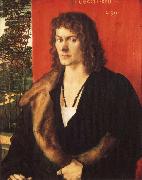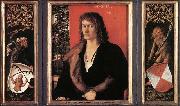Wholesale Oil Painting Reproductions No Minimum and Door to Door! |
|||||||||||
|
|
|||||||||||

|
|||||||||||
|
|
|
||||||||
All Albrecht Durer Oil Paintings |
||||||||
|
|
||||||||
|
|
||||||||
|
Artist Introduction: b.May 21, 1471, Imperial Free City of Nernberg [Germany]
d.April 6, 1528, Nernberg
Albrecht Durer (May 21, 1471 ?C April 6, 1528) was a German painter, printmaker and theorist from Nuremberg. His still-famous works include the Apocalypse woodcuts, Knight, Death, and the Devil (1513), Saint Jerome in his Study (1514) and Melencolia I (1514), which has been the subject of extensive analysis and interpretation. His watercolours mark him as one of the first European landscape artists, while his ambitious woodcuts revolutionized the potential of that medium. D??rer introduction of classical motifs into Northern art, through his knowledge of Italian artists and German humanists, have secured his reputation as one of the most important figures of the Northern Renaissance. This is reinforced by his theoretical treatise which involve principles of mathematics, perspective and ideal proportions.
His prints established his reputation across Europe when he was still in his twenties, and he has been conventionally regarded as the greatest artist of the Renaissance in Northern Europe ever since. |
||||||||
|
|
||||||||
|
Portrait of Oswolt Krel Painting ID:: 30448 |
mk68
Oil on limewood
19 1/2x15 1/4"
Munich
Alte Pinakothek
1499
Alte Pinakothek
|
|||||||
Height Width |
INS/CM Quality |
|||||||
|
X |
| |||||||
|
|
||||||||
All Albrecht Durer Oil Paintings |
||||||||
|
|
||||||||
|
|
||||||||
|
Artist Introduction: b.May 21, 1471, Imperial Free City of Nernberg [Germany]
d.April 6, 1528, Nernberg
Albrecht Durer (May 21, 1471 ?C April 6, 1528) was a German painter, printmaker and theorist from Nuremberg. His still-famous works include the Apocalypse woodcuts, Knight, Death, and the Devil (1513), Saint Jerome in his Study (1514) and Melencolia I (1514), which has been the subject of extensive analysis and interpretation. His watercolours mark him as one of the first European landscape artists, while his ambitious woodcuts revolutionized the potential of that medium. D??rer introduction of classical motifs into Northern art, through his knowledge of Italian artists and German humanists, have secured his reputation as one of the most important figures of the Northern Renaissance. This is reinforced by his theoretical treatise which involve principles of mathematics, perspective and ideal proportions.
His prints established his reputation across Europe when he was still in his twenties, and he has been conventionally regarded as the greatest artist of the Renaissance in Northern Europe ever since. |
||||||||
|
|
||||||||
|
|
Portrait of Oswolt Krel Painting ID:: 63737 |
1499 Oil on panel, 50 x 39 cm (central), 50 x 16 cm (each side panel) Alte Pinakothek, Munich Inscription in the top left by someone else (?): OSWOLT KREL 1499. This portrait comes from the collection of the Princes Oettingen-Wallerstein, who had acquired it in 1812; if has been in its present location since 1928. It is presumed that Oswolt Krell, a merchant for the Ravensburg House in Nuremberg from 1495 to 1503, had asked the artist for a true portrait of representation. Its notable size, similar to that adopted by D?rer for the portrait of his father two years earlier, and its setting, a half-length, suggests this. In this way, it differs from the Tucher portraits, which were intended for private use. The background, as in the Tucher portraits (Schlossmuseum, Weimar), is divided between the curtain and landscape passage, unlike those, however, it is divided rather unevenly. The bright red curtain is wide and occupies most of the space on the right; the landscape, on the left, is reduced to a foreshortening that shows a small part of a river that meanders toward the back, behind a group of tall trees. The windowsill that separated the subject from the landscape in the Tucher paintings is absent. The figure represented, set with obvious grandiosity, is found in front of the curtain, highlighted by intense colour. The large fur-lined cloak is casually placed on the right shoulder only, to show, on the left side, the rich black garment with the puffed sleeve. To the disorderly folds of the cloak correspond the parallel horizontal folds of the sleeve and the vertical ones of the garment. The three-quarter position allows the painter to bring out the quality of the attire: the fur, silk shirt, and gold chain. The careful, fastidious representation of these meaningful details creates a powerful foundation for the setting of the head: vigorous, strong features, the pronounced nose and the strong-willed mouth, the furrowed eyebrows, as if from a sudden start or fright that makes him direct his gaze off to the side behind him. Everything works to make his face threateningly severe, which even the soft, light brown hair framing him does not attenuate. To the energetic expression of the face corresponds the nervous look of his left hand clutching his cloak and that of the contraction of the knotted fingers of the right hand that leans on an invisible window sill. Colour, form, and proportion heighten the expression of supreme resolution, an expression that is the result of a serious psychological study that D?rer conducted on the merchant, who was the same age as the artist and who was later to become the mayor of Lindau, his native city. The two side panels that represent two "sylvan men" are wings to the portrait. They bear the heraldic shields of the subject and his wife, Agathe von Esendorf. They originally let the portrait be closed from the retro; one could imagine, then, that despite the large dimensions, the painting was to be conserved closed. The present frame has been made recently.Artist:D?RER, Albrecht Title: Portrait of Oswolt Krel Painted in 1501-1550 , German - - painting : portrait |
||||||
Height Width |
INS/CM Quality |
|||||||
|
X |
| |||||||
|
|
||||||||
|
Prev Next
|
||||||||
|
|
||||||||
|
Related Paintings to Albrecht Durer :. |
||||||||
|
|
||||||||
|
CONTACT US |


